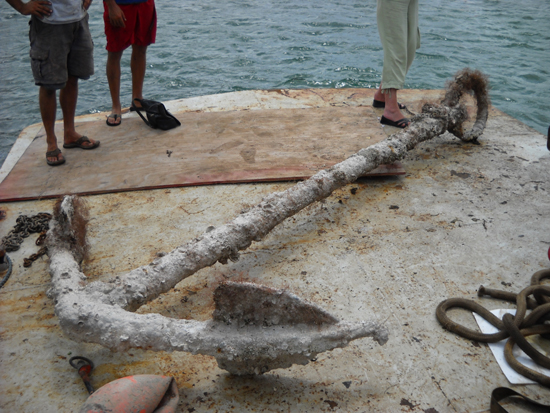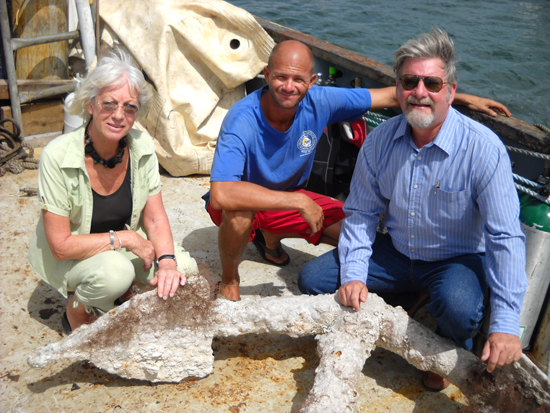 On August 13, 2009, an historic anchor was found by divers during the sea bottom cleaning operations in preparation for the Great Bay dredging. Upon realization of the importance of the find, Deon Swarts, director of Aquatic Solutions, called in the discovery to Lievense project director Rogier Brans, who then contacted Paul Martens of the Fire Department. Mr. Martens called the St. Maarten Museum director, Elsje Bosch and the SIMARC president (and Archaeology authority for VROM), Dr. Jay Haviser, who both immediately went to see the artifact on one of the diving boats. Onboard they saw that this is a large (3.5 meter long) historic anchor covered with coral and barnacles, often referred to as a ‘Fisherman’s type’ anchor, which probably dates from the 19th century.
On August 13, 2009, an historic anchor was found by divers during the sea bottom cleaning operations in preparation for the Great Bay dredging. Upon realization of the importance of the find, Deon Swarts, director of Aquatic Solutions, called in the discovery to Lievense project director Rogier Brans, who then contacted Paul Martens of the Fire Department. Mr. Martens called the St. Maarten Museum director, Elsje Bosch and the SIMARC president (and Archaeology authority for VROM), Dr. Jay Haviser, who both immediately went to see the artifact on one of the diving boats. Onboard they saw that this is a large (3.5 meter long) historic anchor covered with coral and barnacles, often referred to as a ‘Fisherman’s type’ anchor, which probably dates from the 19th century.
This quick response cooperation between Lievense, Aquatic Solutions divers, Fire department, VROM, St. Marten Museum and SIMARC, shows a responsible procedure being conducted during the operations in Great Bay, with regard to archaeological / historic artifacts found. Indeed, this case is a very good example of efficient application of the Malta Treaty international requirements for the proper deposit of historic objects, which are found under the sea and must be provided to the related government authorities. The Netherlands Antilles ratified the Malta Treaty in 2007, thus its application to St. Maarten also applies. As well, the SIMARC already does conduct periodic walking surveys of the sand dredged from the bay, to investigate what materials are found and to make artifact collections if necessary.
 This historic anchor will now be deposited at the SIMARC archaeological facility for about a month, to have the SIMARC students carefully remove the coral and barnacles. After that cleaning, the anchor must be submerged in fresh water for about a year to remove the chloride from the seawater imbedded in the iron. After that soaking, the anchor will be treated with specific chemicals for preservation, and then it can be displayed for the public. The location of display will be decided at a later date, closer to the time the SIMARC conservation measures are finished.
This historic anchor will now be deposited at the SIMARC archaeological facility for about a month, to have the SIMARC students carefully remove the coral and barnacles. After that cleaning, the anchor must be submerged in fresh water for about a year to remove the chloride from the seawater imbedded in the iron. After that soaking, the anchor will be treated with specific chemicals for preservation, and then it can be displayed for the public. The location of display will be decided at a later date, closer to the time the SIMARC conservation measures are finished.